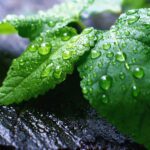Plant phenological stages are the various moments or phases that plants go through during their life cycle in response to environmental changes, especially those related to climate. These stages may include germination, vegetative growth, flowering, fruiting, and fruit ripening. Phenology is important for understanding how plants respond to their environment and for optimizing agricultural practices such as planting, harvesting, and pest and disease management.
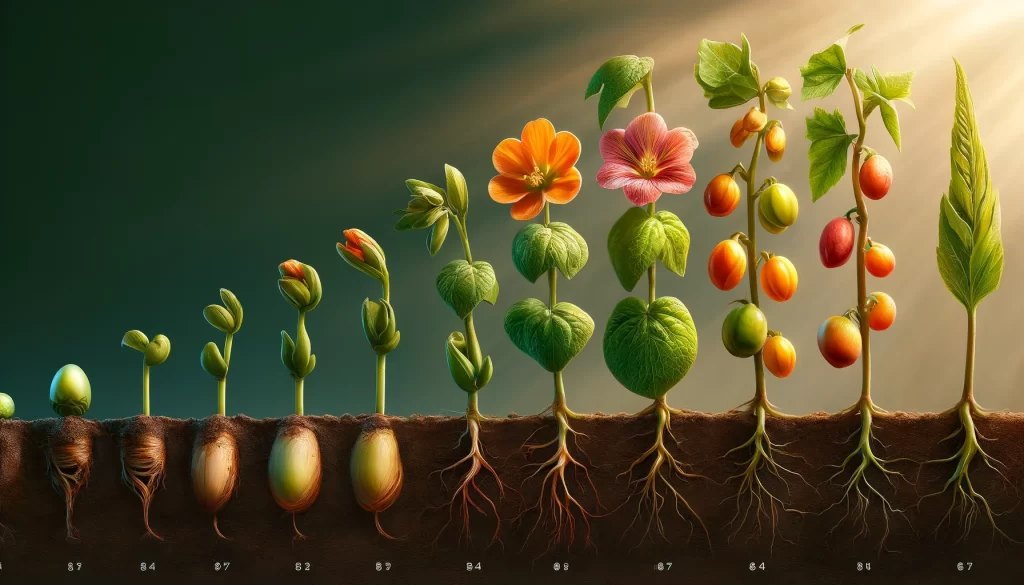
What is a phenological stage or development phase in plants?
A plant’s phenological stage is a specific phase in the plant’s life cycle characterized by discernible and predictable changes in its development and phenotype in response to environmental factors such as temperature, light, humidity, and the availability of water and nutrients. These stages are crucial for understanding and effectively managing crops and ecosystems.
What does a phenological stage or development phase entail?
1. Identification and Description
Each phenological stage is identified and described through observable and measurable criteria. This may include features such as the appearance of vegetative structures (leaves, shoots), flowering, fruit development, color change, or ripening.
2. Duration and Sequence
Each phenological stage has a characteristic duration that can vary depending on the plant species, climatic conditions, and geographic location. Additionally, these stages follow a predictable and ordered sequence over time, although the duration and timing of each stage may vary from year to year due to environmental conditions.
3. Triggering Factors
Phenological stages are influenced by a combination of internal and external factors. Internal factors include the plant’s genetics and physiology, while external factors may include temperature, light, soil moisture, water and nutrient availability, and day length. The interaction between these factors triggers the transition from one stage to another.
4. Monitoring and Recording
It’s important to monitor and record phenological stages throughout the plant’s life cycle. This can be done through direct observations in the field, tracking phenological indicators such as air temperature, or using phenological models based on meteorological data and historical observations.
5. Practical Applications
Understanding phenological stages is crucial for agricultural planning and management. It allows for optimizing the scheduling of activities such as planting, fertilization and pesticide application, irrigation, and harvesting. It’s also important for predicting and mitigating risks associated with adverse weather events, such as late frosts or droughts during critical stages of plant development.

List of Phenological Stages or Development Phases
Here is a comprehensive list of phenological stages that could be found in various crops or plants:
Dormancy
Period of physiological inactivity before active growth begins, common in temperate climate fruit trees.
Dormancy is a physiological state in which plants temporarily cease their active growth and development, in response to unfavorable environmental conditions or to synchronize their life cycle with the environment. During dormancy, plants may be in a state of metabolic rest, allowing them to conserve energy and survive in adverse conditions.
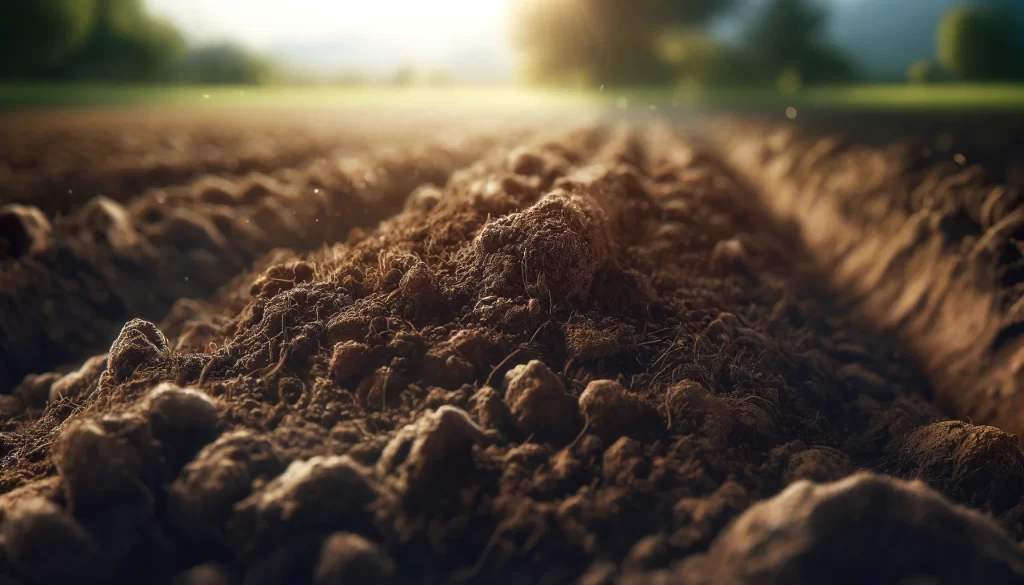
There are several types of dormancy in plants, each adapted to different environmental factors and plant needs:
- Seed Dormancy: Many seeds enter a state of dormancy before germination. This can be caused by factors such as lack of light, extreme temperatures, or the presence of chemical inhibitors in the seed. Seed dormancy helps ensure that germination occurs at an optimal time and place for the plant’s survival.
- Bud Dormancy: Plant buds may enter dormancy during winter to protect themselves from extreme cold. This type of dormancy, known as winter dormancy, prevents buds from developing prematurely and being damaged by frost.
- Shoot Dormancy: Some perennial plants, such as fruit trees, may enter dormancy during winter to conserve energy and protect themselves from the cold. During this period, the growth of new shoots stops until conditions are more favorable in spring.
- Bulb and Tuber Dormancy: Bulbs and tubers, such as those of tulips or potatoes, may enter dormancy during the winter season to protect themselves from cold and desiccation. During this period, metabolism slows down, and the plant preserves its energy reserves in the form of carbohydrates stored in the bulb or tuber.
Overcoming dormancy in plants may require specific environmental stimuli, such as changes in temperature, day length, water availability, or the application of chemical treatments. Once conditions are suitable, plants can exit their dormant state and resume active growth and development. The ability of plants to enter and exit dormancy is an important adaptation that allows them to survive in a wide range of environmental conditions.
Bud Break
Emergence of new buds or vegetative shoots on the plant.
Bud break is a key phenological stage in the life cycle of many plants, characterized by the growth of new vegetative shoots from dormant or latent buds. This phase marks the beginning of active growth for the plant after periods of dormancy or winter rest.

Here are more details about bud break:
- Stimulus for Bud Break: Bud break is typically triggered by increasing temperature and day length that occur with the arrival of spring. These environmental changes signal to the plant that it is safe and conducive to initiate active growth.
- Bud Origins: Buds can arise from different types of buds, such as terminal buds (located at the end of branches), axillary buds (located in the leaf axils), adventitious buds (formed in unexpected places, such as on injured leaves or stems), or basal buds (at the base of the plant). The location of bud break may vary depending on the plant species and its growth pattern.
- Types of Buds: Buds can be of different types, including vegetative buds that will give rise to new leaves and stems, and floral buds that will eventually produce flowers and fruits.
- Patterns of Bud Break: Bud break can occur synchronously throughout the plant or asynchronously, with certain parts of the plant budding before others. This pattern may be influenced by factors such as plant genetics, water and nutrient availability, and exposure to light.
- Agronomic Importance: Bud break is a critical moment for many agricultural crops, as it marks the beginning of the growing season and the appropriate time for pruning, irrigation, and fertilizer application practices. Additionally, the synchronization of bud break with pollinator availability can be crucial for fruit and seed production.
- Bud Break Risks: Early bud break can expose plants to the risk of damage from late frosts, especially in regions with unpredictable spring climates. On the other hand, late bud break can reduce the amount of time available for crop growth and development before the arrival of summer heat.
Leaf Development
Expansion and growth of leaves.
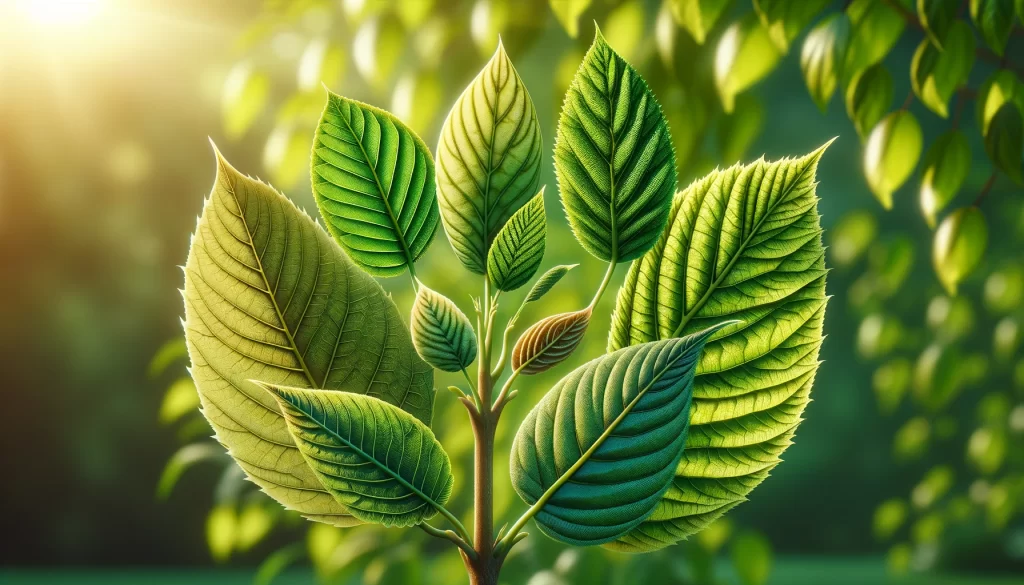
Leaf development is a crucial phenological stage in the plant life cycle, during which leaf structures form and expand to carry out photosynthesis and other vital functions. Here are more details about this process:
- Initiation of Development: Leaf development begins with the emergence of the first leaf buds. These buds may be present on the stems or vegetative shoots of the plant and may be visible even before active growth begins.
- Cellular Expansion: Once the leaf bud starts to grow, cells within the leaf divide and expand to increase their size. This process of cellular expansion is crucial for the development of a fully functional leaf and may be influenced by factors such as water availability, nutrients, and light.
- Tissue Differentiation: During leaf development, cells of different leaf tissues, such as mesophyll, parenchyma, and vascular tissues, differentiate and specialize to perform specific functions. For example, mesophyll cells contain chloroplasts for photosynthesis, while vascular tissues transport water, nutrients, and photosynthetic products throughout the leaf.
- Formation of Leaf Structures: During leaf development, characteristic leaf structures such as the leaf blade, petiole, and veins form. These structures provide physical support and facilitate the capture of sunlight and the circulation of water and nutrients within the leaf.
- Maturation: As leaves continue to develop, they reach physiological maturity, meaning they are fully formed and functional. During this period, leaves may acquire their characteristic color and develop cuticles to reduce water loss.
- Functions: Leaves perform various vital functions for the plant, including photosynthesis (carbohydrate production), transpiration (water loss), respiration (gas exchange), and temperature regulation. Additionally, leaves may also serve as nutrient storage organs in some species.
Stem Development
Growth of vegetative stems.
Stem development is a fundamental process in the plant life cycle, where stems undergo structural growth and differentiation to provide physical support, transport water and nutrients, as well as produce reproductive structures. Here are more details about this process:
- Initiation of Growth: Stem development begins with the activity of meristematic cells located at the tips of stems and in the axillary buds. These cells divide actively and generate new tissues for stem growth.
- Cell Elongation: During this stage, stem cells elongate through cell expansion. This cell elongation is responsible for the longitudinal growth of the stem, allowing it to reach greater heights and penetrate through the soil or towards the light, depending on the species.
- Tissue Differentiation: As the stem grows, meristematic cells differentiate into different types of specialized tissues, such as xylem and phloem for water and nutrient transport, collenchyma and sclerenchyma for structural support, and epidermal tissue for protection and gas exchange regulation.
- Formation of Internodes, Nodes, and Leaves: During stem development, internodes are formed, which are the regions between two nodes where buds and leaves are located. Nodes are the regions where leaves emerge from the stem, and axillary buds may develop into new shoots or branches.
- Production of Reproductive Structures: In many species, stems are also responsible for the production of reproductive structures such as flowers and fruits. During the development of these structures, the stem may undergo morphological modifications to adapt to its specific reproductive functions.
Root Development
Growth and expansion of the root system.
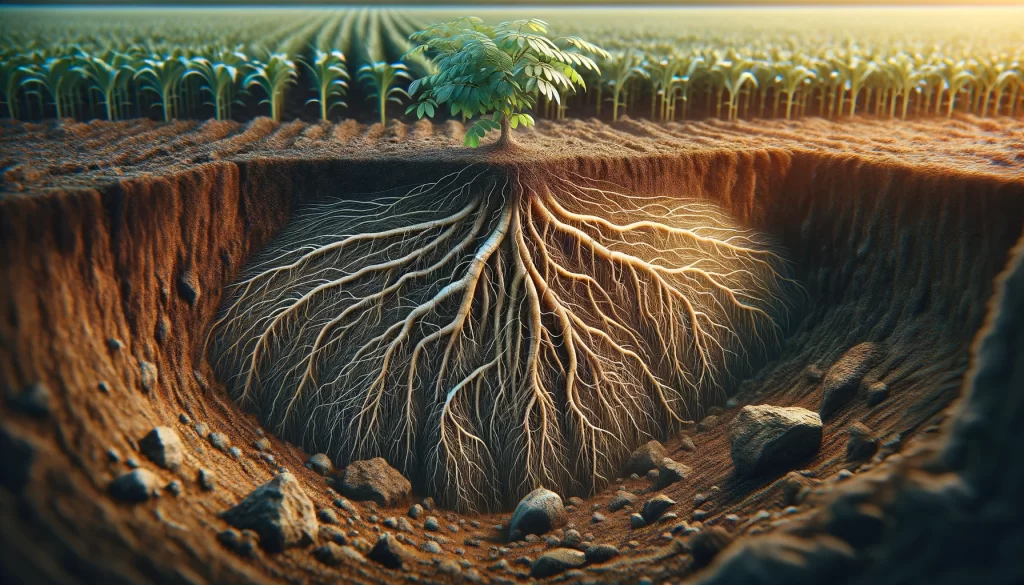
Root development is an essential process in the plant life cycle, where roots undergo structural growth and differentiation to facilitate the absorption of water and nutrients from the soil, provide anchorage and support to the plant, and in some species, store nutrients. Here are more details about this process:
- Germination and Primary Root Formation: Root development begins with seed germination and the formation of the primary root, which emerges from the plant embryo and penetrates into the soil in search of water and nutrients.
- Branching and Formation of Secondary Roots: As the primary root grows, secondary roots are formed from the periphery of the primary root in a process known as branching. These secondary roots increase the plant’s absorption surface and explore a wider area of the soil for resources.
- Tissue Differentiation: During root development, meristematic cells at the root tips differentiate into different types of specialized tissues, such as xylem and phloem for water and nutrient transport, parenchyma for nutrient storage, and epidermal tissue for water absorption and protection.
- Formation of Root Hairs: In the root growth zone, root hairs develop, which are microscopic structures on the surface of roots that increase the plant’s absorption surface and enhance the root’s ability to uptake water and nutrients from the soil.
- Symbiotic Interaction: Some plants form symbiotic associations with mycorrhizal fungi in the roots, enhancing the plant’s ability to absorb nutrients, especially phosphorus and micronutrients, from the soil. Other types of bacteria may form nodules on the roots of leguminous plants, such as beans and peas, and fix atmospheric nitrogen for the plant to utilize.
- Regulation of Growth: Root growth is regulated by a variety of factors, including plant hormones like auxins, water and nutrient availability, soil temperature, and soil structure. These factors can influence the rate and direction of root growth, as well as the formation of specialized structures.
Male/Female Flowering
Production of flowers with male (stamens) or female (pistils) reproductive organs.
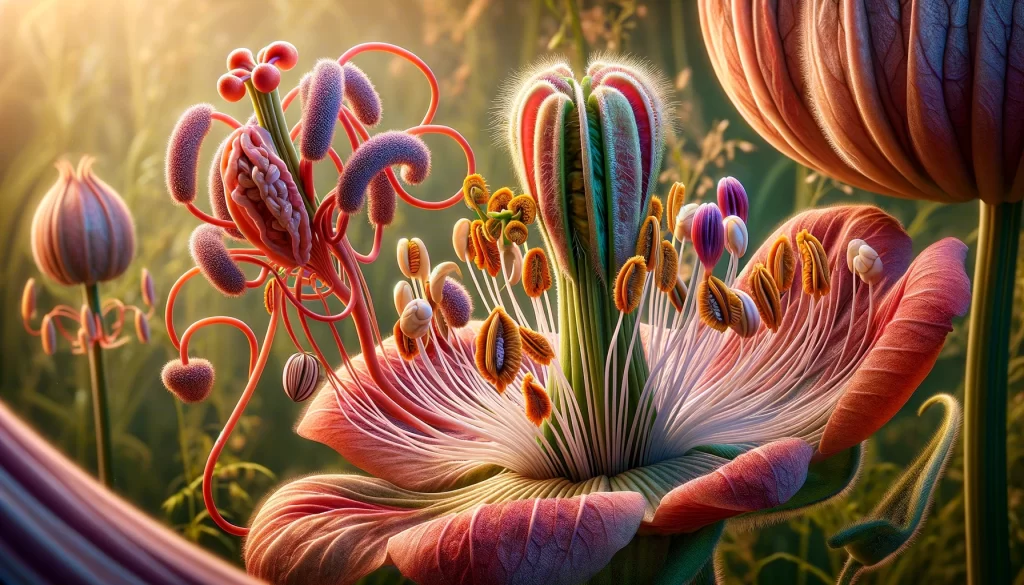
Male and female flowering, also known as male and female anthesis respectively, are key phenological stages in the reproductive cycle of flowering plants (angiosperms). During these stages, plants produce flowers with male (stamens) or female (carpels) sexual organs, enabling them to sexually reproduce through pollination. Here are more details about male and female flowering:
Male Flowering (Male Anthesis):
- Production of Male Flowers: During male flowering, the plant produces flowers containing male sexual organs called stamens.
- Structure of Male Flower: Each stamen consists of a thin filament holding an anther, where pollen grains are produced and released.
- Pollen Development: During male anthesis, pollen grains mature in the anthers and are ready to be dispersed for pollination.
- Reproductive Function: The pollen released during male flowering can be carried by wind, insects, birds, or other means to female flowers for pollination and seed formation.
Female Flowering (Female Anthesis):
- Production of Female Flowers: During female flowering, the plant produces flowers containing female sexual organs called carpels.
- Female Flower Structure: Each carpel consists of an ovary containing ovules, a style connecting the ovary to the receptive stigma, and a stigma receiving pollen.
- Pollen Reception: During female anthesis, the stigma is receptive for capturing pollen transported from male flowers.
- Fertilization and Seed Formation: If successful pollination occurs, pollen germinates on the stigma, and the pollen tube grows through the style to reach the ovules in the ovary, where fertilization occurs, and seeds are formed.
It’s important to note that in some plant species, a flower may contain both male and female sexual organs (hermaphrodite flowers), while in other species, flowers are unisexual and produced on separate plants (dioecious plants). Precise coordination between male and female flowering is essential for the reproductive success of flowering plants and the production of viable offspring.
Polinización
- Types of Pollination:
- Entomophilous Pollination: Carried out by insects such as bees, butterflies, and beetles.
- Ornithophilous Pollination: Carried out by birds, mainly hummingbirds.
- Chiropterophilous Pollination: Carried out by bats.
- Anemophilous Pollination: Carried out by the wind.
- Hydrophilous Pollination: Carried out by water.
- Autogamous Pollination: Carried out by the plant itself, without the aid of external agents.
- Mechanisms of Pollination:
- Zoophilous Pollination: In this type of pollination, animals carry pollen from one flower to another while seeking food or shelter.
- Anemophilous Pollination: In this type of pollination, pollen is carried by the wind from the anthers of one flower to the stigmas of another.
- Autogamous Pollination: In this type of pollination, pollen is transferred to the stigmas of the same flower or another flower on the same plant.
- Importance of Pollination: Pollination is a fundamental process for the sexual reproduction of many flowering plants and is crucial for the production of fruits, seeds, and other agricultural products. Additionally, pollination contributes to the genetic diversity of plant populations and is essential for maintaining the biodiversity and stability of ecosystems.
- Polinization Process: The pollination process involves several steps, including the transfer of pollen from the anthers of the male flower to the stigmas of the female flower, pollen germination on the stigma, the growth of the pollen tube through the style to the ovules in the ovary, and finally, fertilization of the ovule to form the seed.
Initiation of Fruit Formation
After pollination, the initiation of fruit formation begins from the ovary of the flower.

The initiation of fruit formation is a critical stage in the life cycle of flowering plants, where the fertilized ovary begins to develop and transform into a mature fruit containing the seeds. Here are more details about this process:
- Fertilization: The initiation of fruit formation occurs after successful fertilization of the flower has taken place. During pollination, pollen transferred from the stamens of one flower is deposited on the receptive stigma of another compatible flower, leading to pollen germination and the growth of the pollen tube towards the ovules in the ovary.
- Ovary Development: After fertilization, the ovary of the flower begins to develop and grow. Ovary cells divide and expand to form the structure of the fruit that will surround the seeds.
- Ovary Transformation into Fruit: During ovary development, morphological and biochemical changes occur that transform the floral structure into a mature fruit. This may involve the formation of additional tissues, such as the pericarp, which surrounds the seeds and provides protection and support for seed development.
- Fruit Growth: As the fruit continues to develop, it may undergo additional growth in size and weight as cells expand and accumulate water, sugars, and other nutrients. Fruit growth may be regulated by factors such as water availability, nutrients, temperature, and the plant’s hormonal activity.
- Fruit Ripening: Once the fruit has reached its maximum size, the ripening process begins, during which fruit tissues undergo biochemical and physiological changes that affect their taste, color, texture, and nutritional composition. Fruit ripening may be associated with the breakdown of compounds such as starch into simple sugars and the accumulation of pigments responsible for the fruit’s characteristic color.
- Seed Dispersal: After fruit ripening, the seeds are ready to be dispersed into the surrounding environment, where they can germinate and establish new plants. Seed dispersal can occur through a variety of mechanisms, including wind, water, animals, and gravity.
Fruit Development
- Fertilization: Fruit development begins after successful fertilization of the flower. During pollination, pollen transferred from the stamens of one flower is deposited on the receptive stigma of another compatible flower, leading to pollen germination and growth of the pollen tube toward the ovules in the ovary.
- Early Fruit Formation: After fertilization, the flower’s ovary starts to develop and grow to form the incipient fruit. At this stage, the fertilized ovary may be small and not much different from the original flower.
- Fruit Expansion: As fruit development progresses, ovary cells divide and expand, resulting in an increase in fruit size and mass. This growth can occur through the accumulation of water, sugars, and other nutrients in the fruit.
- Tissue Differentiation: During fruit development, ovary cells differentiate into different types of tissues that will form the structure of the mature fruit. This may include the formation of the pericarp, which consists of the fruit wall and may be divided into three layers: the exocarp (outer layer), the mesocarp (middle layer), and the endocarp (inner layer).
- Compound accumulation: During fruit development, a variety of compounds may accumulate, including sugars, organic acids, pigments, vitamins, and aromatic compounds. These compounds can contribute to the flavor, color, aroma, and nutritional value of the ripe fruit.
- Fruit ripening: Fruit ripening is the final process in fruit development, during which the fruit reaches its final size and shape, and accumulated compounds adjust to give the fruit its characteristic flavor, color, and texture. Fruit ripening may be associated with changes in firmness, sugar content, acidity, and the production of ethylene, a plant hormone that regulates ripening.
- Seed dispersal: After fruit ripening, the seeds are ready to be dispersed into the surrounding environment, where they can germinate and establish new plants. Seed dispersal can occur through a variety of mechanisms, including wind, water, animals, and gravity.
Seed Maturation
Process in which seeds reach their physiological maturity and are ready for dispersal.
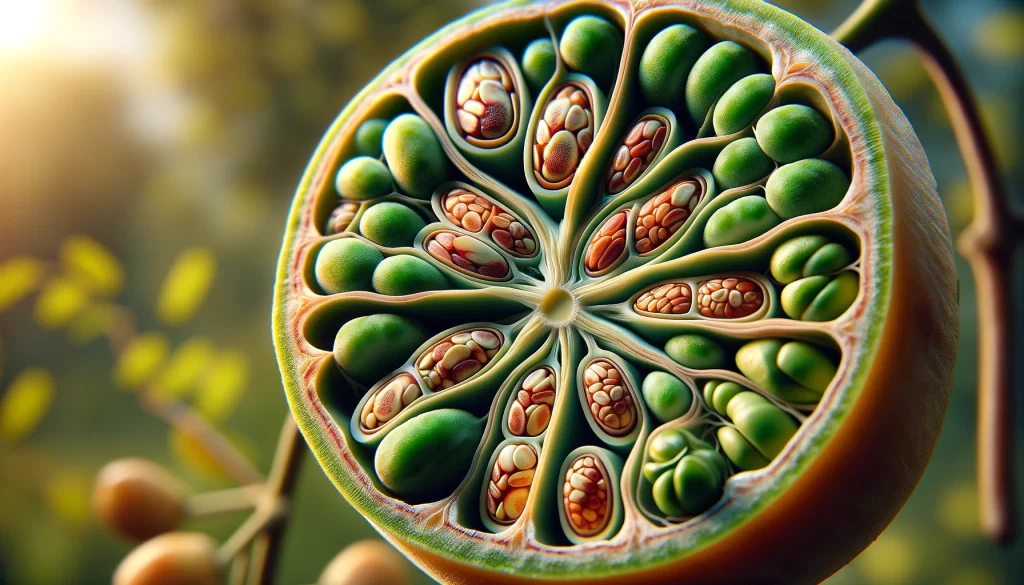
Seed maturation is a crucial process in the life cycle of flowering plants (angiosperms), where developed seeds acquire the ability to germinate and give rise to a new plant. Here are more details about this process:
- Embryonic development: Seed maturation begins with the successful fertilization of the ovules within the flower’s ovary. After fertilization, the resulting zygote divides and develops to form the embryo, which consists of a miniature seedling with an embryonic axis and one or two cotyledons (seed leaves).
- Accumulation of reserves: During seed maturation, nutrient reserves accumulate within the endosperm (storage tissue) or the embryo’s cotyledons. These reserves may include carbohydrates, lipids, proteins, and minerals, providing the energy and nutrients necessary for the initial growth of the seedling after germination.
- Development of protective tissues: Simultaneously with embryo development and reserve accumulation, the seed coat (testa) and other protective structures also undergo morphological and biochemical changes. These protective tissues help shield the seed from mechanical damage, desiccation, pathogen attacks, and adverse environmental conditions during dispersal and storage.
- Induction of dormancy: In some plant species, mature seeds enter a state of physiological dormancy, where their metabolism slows down, and their growth temporarily ceases. Dormancy can be caused by internal and external factors, such as incomplete maturation, lack of light, exposure to extreme temperatures, or the presence of chemical inhibitors.
- Seed dispersal: Once seeds have reached physiological maturity, they are ready to be dispersed into the surrounding environment. Seed dispersal can occur through a variety of mechanisms, including wind, water, animals, and gravity. This process helps plants colonize new habitats and increase the genetic diversity of their populations.
- Germination: When environmental conditions are suitable, mature seeds can germinate, meaning the embryo is reactivated and begins to grow. During germination, the reserves stored in the seed are used to provide energy and nutrients to the emerging seedling as it establishes its roots and begins to grow.
Fruit Maturation
Process in which fruits acquire their characteristic size, color, flavor, and texture.

Fruit maturation is a fundamental process in the life cycle of flowering plants (angiosperms), where the plant’s reproductive organs develop distinctive characteristics such as color, flavor, texture, and aroma, making them attractive to animals and facilitating seed dispersal. Here are more details about this process:
- Onset of ripening: Fruit maturation begins after fertilization is complete and the fertilized ovary has started to develop. At this stage, the fruit may be small, green, and inedible.
- Color change: As the fruit matures, it may undergo changes in color, transitioning from green to yellow, red, orange, purple, or other colors characteristic of the species. This color change can be caused by the synthesis of pigments such as anthocyanins, carotenoids, and chlorophyll, as well as the degradation of chlorophyll.
- Development of flavor and aroma: During maturation, organic compounds in the fruit may undergo biochemical changes that affect their flavor and aroma. For example, sugars may accumulate, acids may decrease, and volatile compounds responsible for the characteristic aroma of the fruit may be produced.
- Changes in texture and firmness: Fruit maturation can also be associated with changes in its texture and firmness. Some fruits may become softer and juicier as they ripen, while others may become crunchier or fibrous.
- Seed development: During fruit maturation, the seeds inside the fruit may also mature and develop. Seeds may accumulate nutrient reserves and develop specialized structures, such as endosperm and embryo, which allow them to survive and germinate when dispersed.
- Development of fruit covering: In addition to internal changes, the fruit covering may undergo morphological and biochemical changes during maturation. For example, the fruit skin may become thinner and smoother, or it may develop structures such as waxes or hairs that help protect the mature fruit from physical damage and pathogens.
- Induction of seed dispersal: Fruit maturation often coincides with the induction of seed dispersal, where the mature fruit becomes attractive to animals that consume it and disperse the seeds through their excreta.
Leaf Fall (Leaf Abscission)
Natural shedding of plant leaves, common in deciduous species.

Leaf fall, also known as leaf abscission, is a natural process in the life cycle of many plants, where mature leaves detach from the stems and fall to the ground. This process is important for the plant’s survival and is regulated by a series of internal and external factors. Here are more details about leaf fall:
- Internal Factors:
- Senescence: Mature leaves eventually enter a state of senescence, where they undergo programmed aging and begin to degrade. During this process, biochemical and physiological changes occur in the leaf cells, such as chlorophyll degradation and nutrient redistribution.
- Ethylene Production: Ethylene is a plant hormone that plays a significant role in regulating leaf abscission. During leaf senescence, leaf cells may produce and release ethylene, which induces the activation of enzymes that degrade the cell wall and facilitate leaf detachment from the stem.
- External Factors
- Seasonal Changes: In many plant species, leaf fall is associated with seasonal changes in temperature and day length. For example, in temperate climates, plants may shed their leaves during autumn as part of their preparation for winter.
- Adverse Environmental Conditions: Leaf fall can also be induced by adverse environmental conditions such as drought, extreme heat, intense cold, frost, strong winds, or damage by insects and diseases. These factors can stress the plant and lead to premature leaf abscission as a way to conserve resources and protect itself.
- Infections: Pathogen infections, such as fungi, bacteria, or viruses, can cause damage to the leaves and trigger leaf abscission as part of the plant’s defense response.
- Abscission Mechanism:
- Leaf abscission involves the activation of a layer of specialized cells called the abscission zone, located at the base of the leaf petiole.
- During senescence, the cells in the abscission zone weaken and separate, forming a layer of weak cells called the abscission layer.
- When the cells in the abscission layer break, the leaf separates from the stem and falls to the ground. This process is facilitated by the action of wind and gravity.
Senescence
Aging and eventual death of the plant’s vegetative parts.
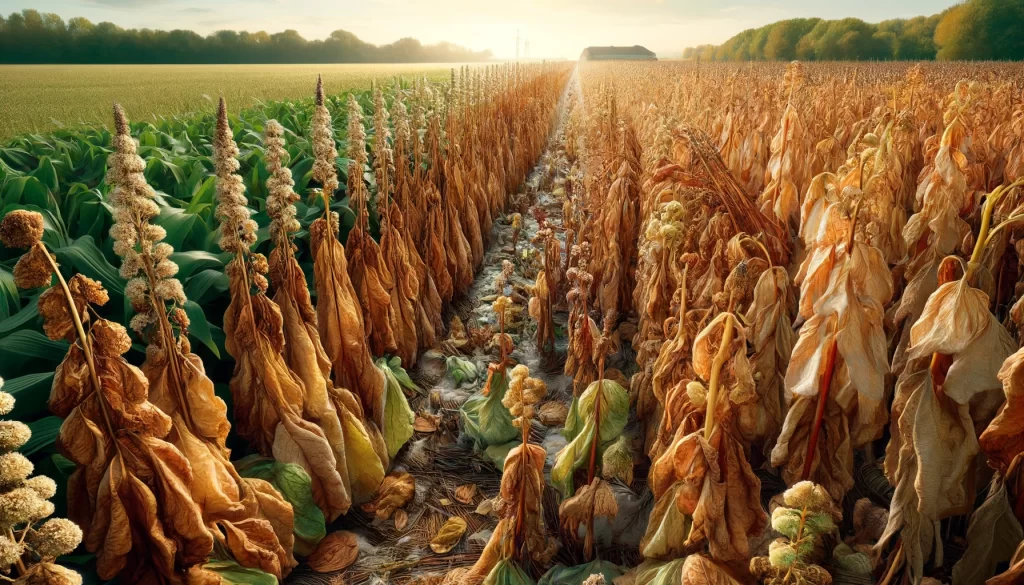
Senescence is the biological process of aging that occurs in cells, tissues, organs, and living organisms. In the context of plants, senescence refers to the process of aging and decline of plant structures, such as leaves, stems, flowers, and roots. Here are more details about senescence in plants:
- Initiation and Development:
- Senescence can be genetically programmed and/or induced by environmental factors.
- In plants, senescence can be part of the natural growth and development cycle, such as leaf senescence that occurs in autumn, or it can be induced by stress, mechanical damage, pathogens, drought, among other factors.
- Morphological Changes:
- During senescence, cells and tissues can undergo visible morphological changes, such as leaf discoloration, yellowing, wilting, and decomposition.
- In leaves, senescence may be accompanied by chlorophyll degradation, loss of turgor pressure, and accumulation of pigments such as carotenoids and anthocyanins.
- Biochemical and Physiological Changes:
- At the biochemical level, senescence involves the activation of specific metabolic pathways leading to the degradation of macromolecules such as proteins, lipids, and nucleic acids.
- During senescence, changes in enzyme activity occur, along with the accumulation of storage compounds and redistribution of nutrients from senescent tissues to other parts of the plant.
- Functions and Benefits:
- Despite commonly being associated with cellular decline and death, senescence serves important functions in plants.
- Leaf senescence, for example, allows plants to reallocate resources to other parts of the plant, such as roots and shoots, during periods of stress or adverse conditions.
- Senescence can also be important for the removal of damaged or infected tissues, helping the plant conserve resources and limit the spread of pathogens.
- Hormonal Regulation:
- Senescence is regulated by a variety of plant hormones, including ethylene, abscisic acid (ABA), cytokinins, and gibberellins.
- These hormones interact to control the onset, progression, and duration of senescence in different tissues and environmental conditions.
Harvest
The moment when crops are ready to be collected for consumption or processing.
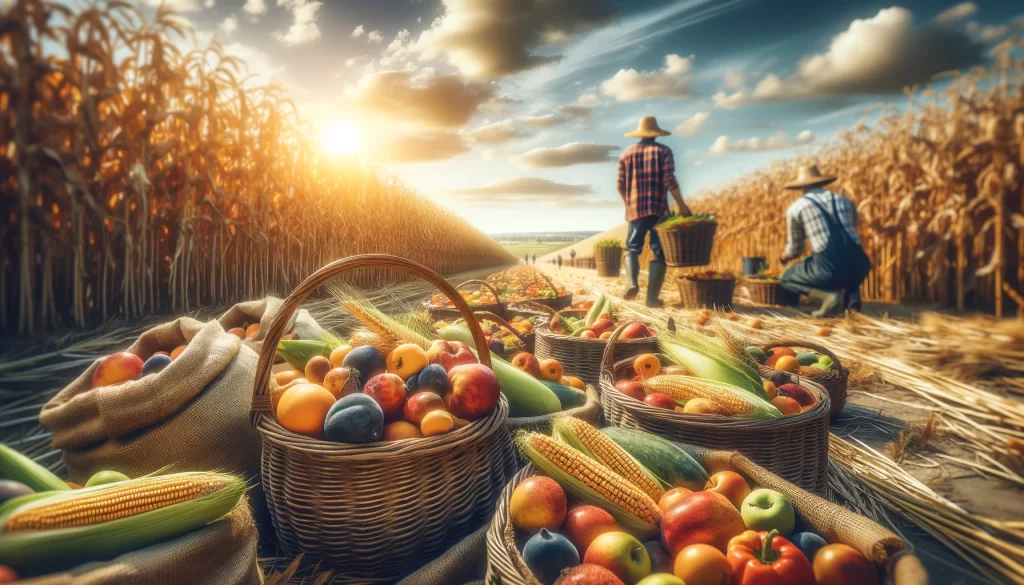
Harvest is the process of gathering mature agricultural crops ready for marketing or consumption. This process is crucial in agriculture and represents the culmination of agricultural work. Here are more details about harvest:
- Determination of Harvest Time:
- The optimal timing for harvest varies depending on the type of crop and climatic conditions.
- Several factors must be considered, such as the maturity status of the crops, moisture content, size, color, texture, flavor, and quality of the products.
- For some crops, such as fruits and vegetables, maturity tests are conducted, such as pulp pressure, skin color, aroma, and sweetness, to determine the ideal harvest time.
- Harvesting Methods:
- Harvesting methods vary depending on the type of crop and agricultural practices. Some crops may be harvested by hand, while others may be mechanically harvested using specialized agricultural machinery.
- Manual harvesting is common in crops like delicate fruits, vegetables, herbs, and high-value products, where care and precision are required.
- Mechanical harvesting is more common in large-scale crops such as cereals, oilseeds, and legumes, where harvesters, mowers, and other agricultural equipment are used to efficiently collect crops.
- Storage and Processing:
- After harvest, crops may be transported to storage or processing facilities where they can be sorted, cleaned, packed, refrigerated, or processed for further marketing or consumption.
- Proper storage is crucial to preserve the quality and freshness of harvested products. This may involve temperature, humidity, and ventilation control to prevent decomposition and deterioration.
- Marketing and Distribution:
- Once harvested, agricultural products can be marketed and distributed through wholesale or retail channels, such as local markets, supermarkets, agricultural fairs, export, among others.
- Proper packaging and labeling are important to attract consumers and ensure the quality and safety of products during transportation and storage.
- Use of Technology:
- Advanced technologies such as precision agriculture, automation, and robotics are being developed and used to improve the efficiency, productivity, and sustainability of harvest and post-harvest processes.
Dormancy
A period of rest or physiological inactivity in perennial plants, common in fruit trees and vineyards.

Dormancy is a physiological process that some seeds experience before germination. During dormancy, seeds enter a state of temporary inactivity that delays their germination, even when environmental conditions are favorable. This process is crucial to ensure that germination occurs at the right time and place for the plant’s survival. Here are more details about seed dormancy:
- Causes of Dormancy:
- Dormancy can be caused by a variety of internal and external factors, such as seed coat structure, lack of light, temperature, humidity, presence of chemical inhibitors, and physiological maturity of the seed.
- The structure of the seed coat may be impermeable to water or have hardness that prevents the entry of water and gases necessary for germination.
- Some seeds produce chemical compounds that inhibit germination until environmental conditions are suitable for plant growth.
- Types of Dormancy:
- Dormancy can be classified into different types based on its cause and duration.
- Physical dormancy is due to impermeability or hardness of the seed coat.
- Physiological dormancy is regulated by internal factors such as physiological maturity of the seed and presence of chemical inhibitors.
- Chemical dormancy occurs due to the presence of chemical inhibitors in the seed.
- Overcoming Dormancy:
- Dormancy can be overcome by various methods such as mechanical treatment, chemical treatment, scarification, soaking in water, stratification (exposure to cold temperatures), or exposure to light.
- These methods help break or remove the seed coat, deactivate chemical inhibitors, and stimulate the onset of germination.
- Importance of Dormancy:
- Dormancy is a survival mechanism that allows plants to synchronize germination with environmental conditions favorable for plant growth and development.
- Dormancy can also help prevent premature germination during periods of unfavorable environmental conditions, such as droughts or extreme temperatures.
Racimación/espigamiento
Formation and growth of reproductive structures in grain plants, such as wheat and barley.

Racemation, also known as spiking, is a phenological process in the life cycle of some plants, especially grasses and cereals, where the development and growth of the inflorescence, which is the structure containing the flowers, occurs. Here are more details about racemation/spiking:
- Initiation and Development:
- Racemation occurs after the vegetative phase of the plant, when it has completed its growth in height and begins to allocate energy towards the formation of the inflorescence.
- During racemation, the main stem of the plant, known as the floral scape, elongates, and the structure of the inflorescence forms.
- The inflorescence can have different shapes and sizes, depending on the plant species, and may consist of a spike, a panicle, a spikelet, among others.
- Floral Induction:
- Racemation is regulated by a series of internal and external factors, including plant genetics, temperature, light, water and nutrient availability, and the presence of plant hormones such as gibberellins.
- The transition from the vegetative phase to the reproductive phase, known as floral induction, is a critical step in the racemation process. This process is influenced by the interaction of multiple environmental signals and endogenous signals in the plant.
- Reproductive Function:
- Racemation marks the beginning of the reproductive phase of the plant, where flowers, containing the male (stamens) and female (carpels) reproductive organs, are produced and released.
- Pollination of the flowers is crucial for seed formation and the reproductive success of the plant.
- After pollination and fertilization, the flowers develop into fruits containing seeds, which are essential for species propagation.
- Harvest and Yield:
- In cereal and grass crops, racemation is an important time to determine the potential yield of the harvest, as the number of spikes, grain density per spike, and other factors influence the final grain production.
- The racemation stage can also be critical for implementing agronomic practices such as fertilization, weed control, irrigation, and protection against diseases and pests, to maximize yield and harvest quality.
Full Bloom
Stage in which most of the flowers on the plant are open and receptive to pollination.

Full bloom is a crucial stage in the life cycle of many flowering plants, where flowers reach their maximum development and exhibit their characteristic beauty and fragrance. Here are more details about full bloom:
- Onset of Bloom:
- Full bloom marks the point in the plant’s life cycle where flower buds have reached their full development and open to reveal mature flowers.
- The onset of full bloom is influenced by a variety of factors, including plant genetics, weather conditions, water and nutrient availability, and day length.
- Floral Development:
- During full bloom, flowers display their characteristic structure, which may include brightly colored petals, protective sepals, pollen-producing stamens, and carpels containing ovules.
- Flowers can vary in shape, size, color, and fragrance depending on the plant species and the specific reproductive function of the flower.
- Reproductive Function:
- Full bloom is essential for the reproductive function of the plant, as it is during this stage that pollination and fertilization occur.
- Flowers attract pollinators, such as insects, birds, and bats, with their color and fragrance, and provide nectar and pollen as rewards.
- Successful pollination allows for the transfer of pollen from stamens to carpels, leading to seed and fruit formation.
- Importance for Biodiversity:
- Full bloom is critical for biodiversity and ecosystem health, as it provides food and shelter for a variety of pollinators and other organisms.
- Flowering plants play a crucial role in the pollination of agricultural crops, contributing to food security and food production.
- Care and Maintenance:
- During full bloom, it’s important to provide proper care to plants, such as regular watering, fertilization, and pest and disease control, to ensure healthy and prolonged flowering.
- Removing dead flowers and proper pruning can promote the continuous production of new flowers and prolong the flowering season.
Beginning of Grain Filling
Start of the grain filling process in cereal plants.

The beginning of grain filling is a critical stage in the life cycle of grain crops such as corn, wheat, rice, and sorghum, where the process of starch and other nutrient accumulation in developing grains begins. Here are more details about this stage:
- Onset of the Process:
- The beginning of grain filling occurs after successful pollination and fertilization of the flowers, when fertilized ovules begin to develop into grains.
- During this stage, cell division and expansion of endosperm tissue, which is the part of the grain that stores nutrients such as starch, proteins, and lipids, begin.
- Starch and Nutrient Accumulation:
- The grain filling process is driven by photosynthesis in the plant’s leaves, where sugars are produced and transported to the grains, converted into starch, and other nutrients.
- As grain filling progresses, large amounts of starch accumulate in the grain’s endosperm, contributing to increased size and weight of the grain.
- Factors Affecting Grain Filling:
- Grain filling is influenced by a variety of factors, including sunlight availability, temperature, humidity, nutrients, plant genetics, and environmental conditions.
- Favorable conditions, such as moderate temperatures, adequate humidity, and sufficient nutrient supply, can promote optimal grain filling and high crop quality.
- Stress Factors:
- Stress factors such as drought, extreme heat, nutrient deficiency, or pest and disease attacks can negatively affect grain filling and reduce yield and harvest quality.
- Grain Development Stages:
- Grain filling can be divided into several stages, including the initial filling phase, the rapid filling phase, and the late filling phase.
- During the initial filling phase, the groundwork for grain development is established, while during the rapid filling phase, the greatest accumulation of starch and nutrients occurs.
- The late filling phase is a period of grain maturation and drying, where nutrient accumulation is completed, and the grain prepares for harvest.
Sealing of Furrows/Fissures
Stage in which the furrows of fruits begin to close, indicating increased maturity.

Sealing of furrows or fissures is a phenomenon that occurs in some crops, particularly in grains like corn, where longitudinal fissures in the grain husks close during their development. This process is important to ensure grain integrity and quality. Here are more details about furrow/fissure sealing:
- Onset of the Process:
- Furrow sealing generally occurs during the grain filling stage, when grains are fully developing and accumulating starch and other nutrients.
- As grains fill and expand, the husks surrounding them may experience tension due to the internal pressure generated by grain enlargement.
- Sealing Mechanism:
- Furrow sealing is facilitated by the internal pressure exerted by the expanding grain, which acts to close fissures in the husks.
- The ability of husks to seal properly depends on various factors, such as the elasticity of husk cell walls, tissue moisture, and plant structural integrity.
- Importance:
- Furrow sealing is important to prevent moisture loss and moisture entry into the grain, which could lead to premature germination, fungal growth, and decay.
- Additionally, furrow sealing helps maintain the structural integrity of the husk and the grain, facilitating subsequent harvesting and storage.
- Factors Affecting Furrow Sealing:
- The ability of husks to seal properly can be affected by a variety of factors, including water and nutrient availability, temperature, relative humidity, plant genetics, and environmental conditions during grain development.
- Stress conditions such as drought, extreme heat, nutrient deficiency, or pest and disease attacks can interfere with the furrow sealing process and reduce grain quality.
Secondary Root System Development
Formation and expansion of secondary root systems in trees and shrubs.
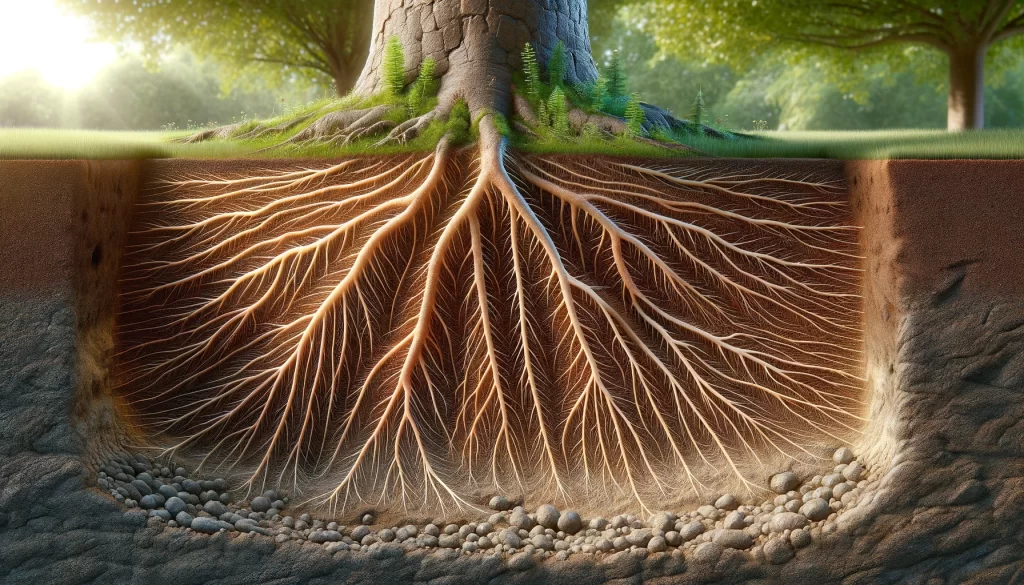
Secondary root system development is a crucial stage in plant growth, where initial primary roots branch out and develop into a more complex and extensive root system. Here are more details about this process:
- Onset of Development:
- Secondary root system development begins after the seedling has established its primary root system, consisting of the taproot and its lateral roots.
- Primary lateral roots can grow from the initial taproot and extend into the soil in search of water, nutrients, and stability.
- Formation of Secondary Roots:
- During secondary root system development, primary lateral roots begin to branch out and form new ramifications, known as secondary roots or second-order roots.
- These secondary roots further branch into tertiary and quaternary roots, creating a three-dimensional network of roots in the soil.
- Functions:
- The secondary root system performs several important functions for the plant, including:
- Water and nutrient absorption from the soil: Secondary roots provide a larger absorption surface to capture water and essential nutrients.
- Anchoring and support: The secondary root system provides stability and anchorage to the plant in the soil, helping to resist forces such as wind and rain.
- Nutrient storage: Some secondary roots can store carbohydrates and other nutrients for later use during periods of active growth or stress.
- Factors Affecting Development:
- Development of the secondary root system can be influenced by a variety of factors, including water availability, nutrients, oxygen, temperature, soil pH, and soil structure.
- Stress conditions such as drought, compacted soils, or soils with low fertility can negatively affect the development of the secondary root system and limit plant growth and yield.
- Importance for Plant Growth:
- A well-developed secondary root system is crucial for the healthy and vigorous growth of the plant, as it provides a steady supply of water and nutrients, stability in the soil, and resistance to environmental stress.
- Proper development of the secondary root system is especially important during critical stages of the plant’s life cycle, such as flowering, grain filling, and maturation, when high demands for water and nutrients are required.
 AgronoBlog – Agriculture Blog
AgronoBlog – Agriculture Blog 
